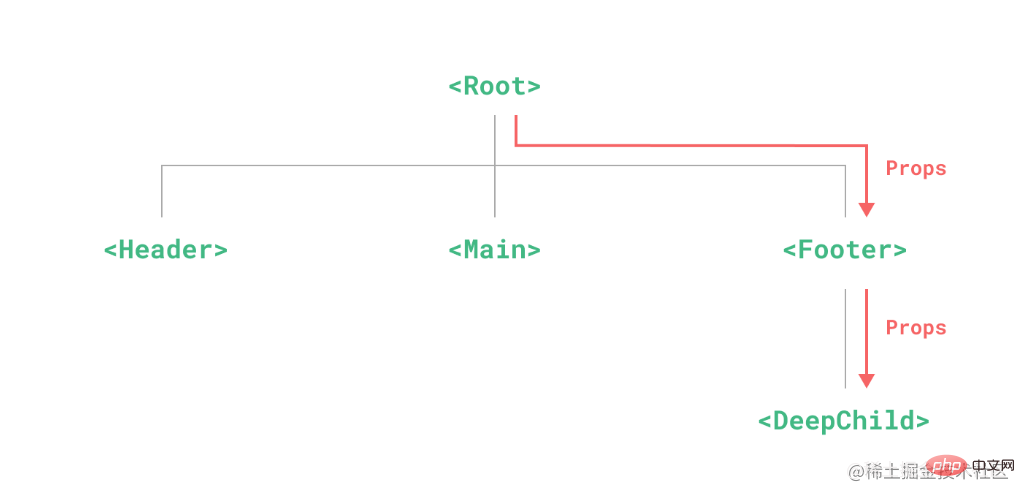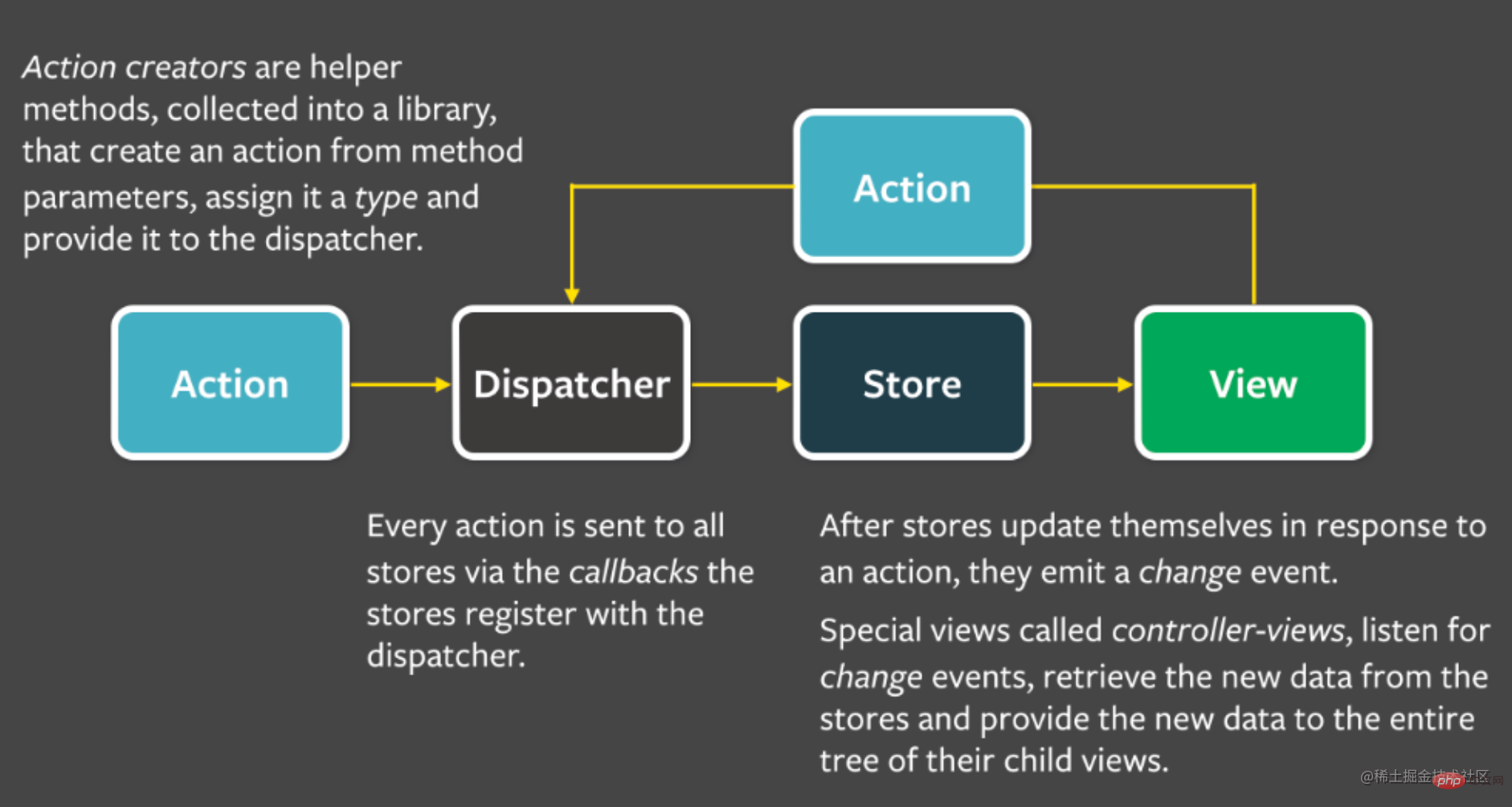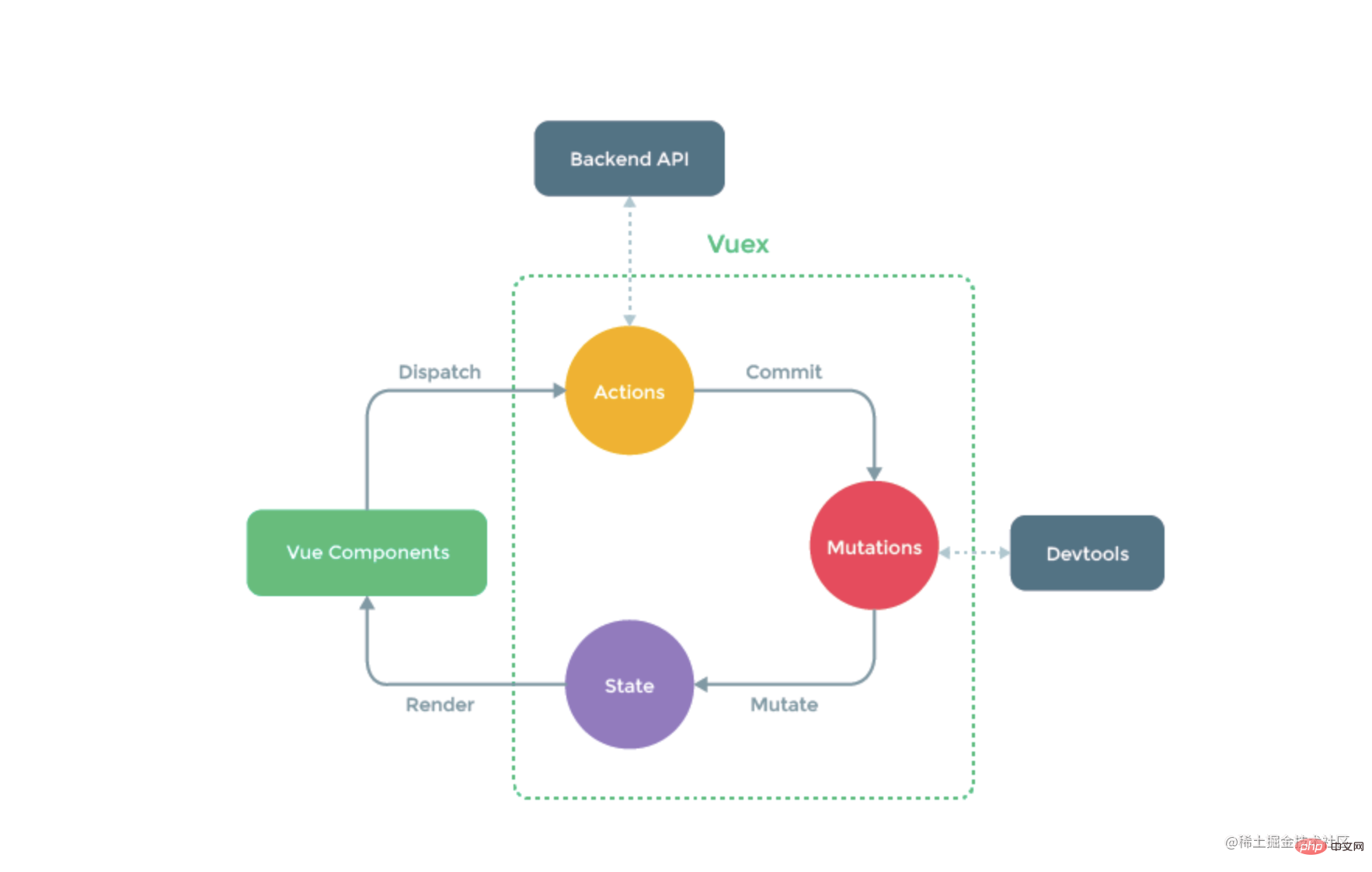

When developing front-end projects, state management is always an unavoidable topic. Vue and the React framework itself provide some capabilities to solve it this problem. However, there are often other considerations when developing large-scale applications, such as the need for more standardized and complete operation logs, time travel capabilities integrated in developer tools, server-side rendering, etc. This article takes the Vue framework as an example to introduce the differences in the design and implementation of the two state management tools, Vuex and Pinia.
First of all, let’s introduce the state management method provided by the Vue framework itself. [Related recommendations: vuejs video tutorial, web front-end development]
The Vue component mainly involves three components: state, action and view.
In the optional API, a state object is returned through the data method, and the action to modify the state is set through the methods method.
If you use the combined API setup syntax sugar, the state is generated through the reactive method, and the action only needs to be defined as a normal function or arrow function.
Optional API:
<script>
export default {
data() { // 状态 state
return {
count: 0
}
},
methods() { // 动作 action
increment() {
this.count++
}
}
}
</script>
// 视图 view
<template> {{ count }} </template>Combined API setup Syntactic sugar:
<script setup>
import { reactive } from 'Vue'
// 状态 state
const state = reactive({
count: 0
})
// 动作 action
const increment = () => {
state.count++
}
</script>
// 视图 view
<template> {{ state.count }} </template>
The view is generated by the state, and the operation can modify the state.
If a certain part of the page can be isolated into an independent entity composed of states, views, and actions that are decoupled from the outside world, then the state management method within the component provided by Vue is enough.
But these two situations are often encountered in development:
For example, if we want to create a theme customization function, we need to obtain the color parameters in the interface at the project entrance, and then use this data in many pages of the entire project.
One way is to use CSS variables, define some CSS variables on the top-level root element of the page, use var() in Sass to initialize a Sass variable, which is referenced by all pages Just this variable. To obtain the interface data at the project entrance, you need to manually modify the css variables on the root element.
In Vue, the framework provides a v-bind way to write css. We can consider storing all color configurations in a unified store.
When encountering these two situations, we usually solve them through communication between components, such as:
props/emitdefineProps({})defineEmits(['change', '...'])provide/inject

##Flux architecture
Flux 是 Facebook 在构建大型 Web 应用程序时为了解决数据一致性问题而设计出的一种架构,它是一种描述状态管理的设计模式。绝大多数前端领域的状态管理工具都遵循这种架构,或者以它为参考原型。
Flux 架构主要有四个组成部分:

整个数据流动关系为:
1、view 视图中的交互行为会创建 action,交由 dispatcher 调度器。
2、dispatcher 接收到 action 后会分发至对应的 store。
3、store 接收到 action 后做出响应动作,并触发 change 事件,通知与其关联的 view 重新渲染内容。
这就是 Flux 架构最核心的特点:单向数据流。
与传统的 MVC 架构相比,单向数据流也带来了一个好处:可预测性。
所有对于状态的修改都需要经过 dispatcher 派发的 action 来触发的,每一个 action 都是一个单独的数据对象实体,可序列化,操作记录可追踪,更易于调试。
Vuex 与 Pinia 大体上沿用 Flux 的思想,并针对 Vue 框架单独进行了一些设计上的优化。
Vuex

store.commit 方法提交一个操作,并将参数传入回调函数。type 和负载 payload。dispatch 方法来触发 action 操作,同样的,参数包含了类型名 type 和负载 payload。commit 来提交 mutation 也能达到一样的效果。module.registerModule 动态注册模块。import { createStore } from 'Vuex'
export default createStore({
state: () => {
return { count: 0 }
},
mutations: {
increment(state, num = 1) {
state.count += num;
}
},
getters: {
double(state) {
return state.count * 2;
}
},
actions: {
plus(context) {
context.commit('increment');
},
plusAsync(context) {
setTimeout(() => { context.commit('increment', 2); }, 2000)
}
}
})与 Vue 选项式 API 的写法类似,我们可以直接定义 store 中的 state、mutations、getters、actions。
其中 mutations、getters 中定义的方法的第一个参数是 state,在 mutation 中可以直接对 state 同步地进行修改,也可以在调用时传入额外的参数。
actions 中定义的方法第一个参数是 context,它与 store 具有相同的方法,比如 commit、dispatch 等等。
通过 state、getters 获取数据,通过 commit、dispatch 方法触发操作。
<script setup>
import { useStore as useVuexStore } from 'Vuex';
const vuex = useVuexStore();
</script>
<template>
<div>
<div> count: {{ vuex.state.count }} </div>
<button @click="() => {
vuex.dispatch('plus')
}">点击这里加1</button>
<button @click="() => {
vuex.dispatch('plusAsync')
}">异步2s后增加2</button>
<div> double: {{ vuex.getters.double }}</div>
</div>
</template>Pinia
保留:
舍弃:
import { defineStore } from 'Pinia'
export const useStore = defineStore('main', {
state: () => {
return {
count: 0
}
},
getters: {
double: (state) => {
return state.count * 2;
}
},
actions: {
increment() {
this.count++;
},
asyncIncrement(num = 1) {
setTimeout(() => {
this.count += num;
}, 2000);
}
}
})可直接读写 state,直接调用 action 方法。
<script setup>
import { useStore as usePiniaStore } from '../setup/Pinia';
const Pinia = usePiniaStore();
</script>
<template>
<div>
<div> count: {{ Pinia.count }}</div>
<button @click="() => {
Pinia.count++;
}">直接修改 count</button>
<button @click="() => {
Pinia.increment();
}">调用 action</button>
<button @click="() => {
Pinia.asyncIncrement();
}">调用异步 action</button>
<div> double: {{ Pinia.double }}</div>
</div>
</template>1、对 state 中每一个数据进行修改,都会触发对应的 mutation。
2、使用 action 对 state 进行修改与在 Pinia 外部直接修改 state 的效果相同的,但是会缺少对 action 行为的记录,如果在多个不同页面大量进行这样的操作,那么项目的可维护性就会很差,调试起来也很麻烦。
Pinia 更加灵活,它把这种选择权交给开发者,如果你重视可维护性与调试更方便,那就老老实实编写 action 进行调用。
如果只是想简单的实现响应式的统一入口,那么也可以直接修改状态,这种情况下只会生成 mutation 的记录。
Pinia 中的 action 提供了订阅功能,可以通过 store.$onAction() 方法来设置某一个 action 方法的调用前、调用后、出错时的钩子函数。
Pinia.$onAction(({
name, // action 名称
store,
args, // action 参数
after,
onError
}) => {
// action 调用前钩子
after((result) => {
// action 调用后钩子
})
onError((error) => {
// 出错时钩子,捕获到 action 内部抛出的 error
})
})Vuex 中的 commit 方法
commit (_type, _payload, _options) {
// 格式化输入参数
// commit 支持 (type, paload),也支持对象风格 ({ type: '', ...})
const {
type,
payload,
options
} = unifyObjectStyle(_type, _payload, _options)
const mutation = { type, payload }
const entry = this._mutations[type]
this._withCommit(() => {
entry.forEach(function commitIterator (handler) {
handler(payload)
})
})
this._subscribers
.slice()
.forEach(sub => sub(mutation, this.state))
}在使用 commit 时,可以直接传入参数 type 和 payload,也可以直接传入一个包含 type 以及其他属性的 option 对象。
Vuex 在 commit 方法内会先对这两种参数进行格式化。
Vuex 中的 dispatch 方法
dispatch (_type, _payload) {
const {
type,
payload
} = unifyObjectStyle(_type, _payload)
const action = { type, payload }
const entry = this._actions[type]
// try sub.before 调用前钩子
try {
this._actionSubscribers
.slice()
.filter(sub => sub.before)
.forEach(sub => sub.before(action, this.state))
} catch (e) {
// ……
}
// 调用 action,对于可能存在的异步请求使用 promiseAll 方式调用
const result = entry.length > 1
? Promise.all(entry.map(handler => handler(payload)))
: entry[0](payload)
return new Promise((resolve, reject) => {
result.then(res => {
// …… try sub.after 调用后钩子
resolve(res)
}, error => {
// …… try sub.error 调用出错钩子
reject(error)
})
})
}从这两个方法的实现中也可以看出 mutations、actions 的内部实现方式。
所有的 mutations 放在同一个对象内部,以名称作为 key,每次 commit 都会获取到对应的值并执行操作。
actions 操作与 mutations 类似,但是增加了一个辅助的数据 actionSubscribers,用于触发 action 调用前、调用后、出错时的钩子函数。
辅助函数 mapXXX
在 Vuex 中,每次操作都要通过 this.$store.dispatch()/commit()。
如果想要批量将 store 中的 state、getters、mutations、actions 等映射到组件内部,可以使用对应的 mapXXX 辅助函数。
export default {
computed: {
...mapState([]),
...mapGetters([])
},
methods: {
...mapMutations(['increment']), // 将 this.increment 映射到 this.$store.commit('increment')
...mapActions({
add: 'incremnet' // 传入对象类型,实现重命名的映射关系
})
}
}在 Pinia + 组合式 API 下,通过 useStore 获取到 store 后,可以直接读写数据和调用方法,不再需要辅助函数。
devtools 支持
当项目涉及的公共数据较少时,我们可以直接利用 Vue 的响应式 API 来实现一个简单的全局状态管理单例:
export const createStore = () => {
const state = reactive({
count: 0;
})
const increment = () => {
state.count++;
}
return {
increment,
state: readonly(state)
}
}为了使代码更容易维护,结构更清晰,通常会将对于状态的修改操作与状态本身放在同一个组件内部。提供方可以抛出一个响应式的 ref 数据以及对其进行操作的方法,接收方通过调用函数对状态进行修改,而非直接操作状态本身。同时,提供方也可以通过 readonly 包裹状态以禁止接收方的直接修改操作。
The above is the detailed content of Let's talk about the differences in design and implementation between Vuex and Pinia. For more information, please follow other related articles on the PHP Chinese website!